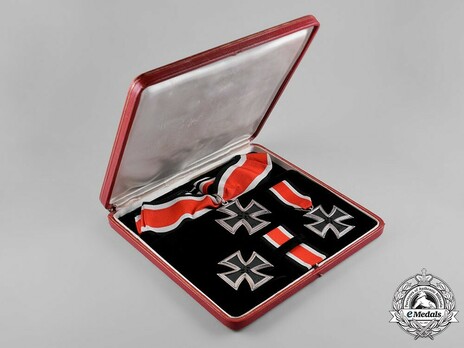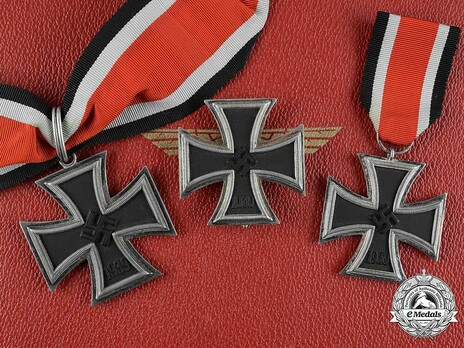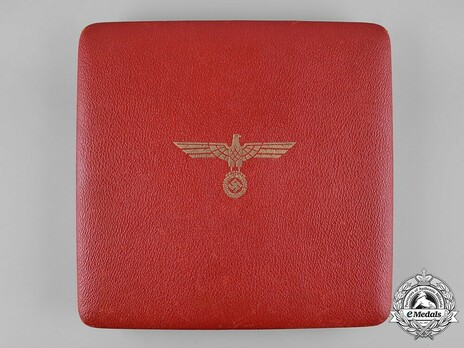Knight's Cross of the Iron Cross, Presentation Set
CATEGORY: Version
SKU: 01.GTR.0101.107.08.000
Estimated market value:



Estimated market value:
(Ritterkreuz des Eisernen Kreuzes Präsentationssatz). Reinstituted 1 September 1939. (1939-1945 issue). eMedals is pleased to offer an extremely rare and ultra desirable Iron Cross presentation set featuring three decorations, including the Knight’s Cross of the Iron Cross, constructed of iron and silver, on loop for suspension from its period original neck ribbon with three functional metal snap buttons marked “PRYM”, consisting of a Cross Pattée with a blackened magnetic iron core within a ribbed silver frame, the obverse with a central mobile swastika, the six o’clock arm with a reinstitution date of “1939”, the reverse six o’clock arm with an initial institution date of “1813”, the suspension ring marked “SILBER” with a LDO code of “21” for maker Gebrüder Godet, Berlin, measuring 48.99 mm (w) x 48.65 mm (h), weighing 31.7 grams, there is evidence of repainting to the core, otherwise in extremely fine condition.
A 1939 Iron Cross I Class, constructed of iron and silver, consisting of a Cross Pattée with a blackened magnetic iron core within a ribbed silver frame, the obverse with a central mobile swastika, the six o’clock arm with a reinstitution date of “1939”, the reverse with a barrel hinge and banjo-style pinback meeting a flat wire catch, the reverse of the pinback marked with an LDO code of “21” for maker Gebrüder Godet, Berlin, measuring 44.54 mm (w) x 44.34 mm (h), weighing 11.4 grams, there is of evidence of repainting to the core, otherwise in extremely fine condition.
An 1939 Iron Cross II Class, constructed of iron and silver, on loop for suspension from its period original ribbon with horizontal pinback, consisting of a Cross Pattée with a blackened magnetic iron core within a ribbed silver frame, the obverse with a central mobile swastika, the six o’clock arm with a reinstitution date of “1939”, the reverse six o’clock arm with an initial institution date of “1813”, the suspension loop marked with an LDO code of “21” for maker Gebrüder Godet, Berlin, measuring 44.31 mm (w) x 44.46 mm (h), weighing 23.5 grams, in extremely fine condition.
Importantly, accompanied by an ultra rare and highly highly sought after original presentation case, constructed of a wood frame with a faux red leather exterior, the obverse lid with a gold embossed Wehrmacht-style German national eagle clutching a wreathed mobile swastika, the interior with a white satin lid liner and an intact hinge cover, with a slotted and depressed black velvet medal bed, opening with a functional bronze spring catch with exterior stud release and dual functional magnetic metal hinges, measuring 200 mm (w) x 200 mm (l) x 25 mm (h), there is evidence of cleaning to the lid liner, otherwise in extremely fine condition; accompanied by a certificate of authenticity by Dietrich Maerz, dated 15 January 2014.
Footnote: While receipt of both the Second and First Class Iron Cross was a prerequisite for the awarding of the Knight’s Cross, exceptions were made on a case-by-case basis, with nominees receiving all three awards simultaneously in a special presentation set. This set, which is unlikely to have actually been awarded, is one of very few known example.
The Iron Cross was originally founded in 1813 and was considered Germany’s highest military decoration. The Iron Cross was conferred upon military personnel who rendered outstanding service and demonstrated unwavering bravery in the face of the enemy. In order to receive a higher grade, an individual had to first receive a lower grade.
On September 1st, 1939, Adolf Hitler renewed the Order of the Iron Cross and introduced a new grade, the Knight’s Cross of the Iron Cross. The Knight’s Cross was conferred upon military personnel of all ranks and in all branches of the Armed Forces who demonstrated extraordinary bravery and courage in battle. Hitler created the Knight’s Cross to bridge the class divide between the I Class and Grand Cross, as throughout previous wars, the Imperial Grand Cross had strictly been conferred upon high-ranking Commanders and nobility.
In Imperial Germany, a common soldier could never hope to receive the Grand Cross of the Iron Cross. However, in Nazi Germany, the Knight’s Cross was obtainable and could transform a lowly soldier into a national hero.
On June 3rd, 1940, a higher grade, the Knight’s Cross with Oak Leaves, was introduced to distinguish individuals who had already won a Knight’s Cross, but continued to demonstrate merit and bravery in battle.
On September 28th, 1941, two higher grades, the Knight’s Cross with Oakleaves and Swords and the Knight’s Cross with Oak Leaves, Swords and Diamonds, was also introduced.
On December 29, 1944, the final grade, the Knight’s Cross with Golden Oak Leaves, Swords and Diamonds, was introduced. The Award was to be conferred upon 12 separate individuals who had already been decorated with all other grades of the Order. However, only one award was ever made, to Oberst Hans-Ulrich Rudel on the date of institution.
The 1939 Knight's Cross of the Iron Cross replaced the Pour le Mérite.
The Knight’s Cross was first produced in 1939 and the prototype was manufactured by Steinhauer & Lück of Lüdenscheid. Eventually, other manufacturing firms were contracted to produce the Knight’s Cross. Each firm was allocated a code number to indicate which decoration they had produced. Official award pieces were regulated by the Präsidialkanzlei, and pieces intended for private purchase were regulated by the LDO. LDO pieces were generally stamped with a maker’s code that had an “L” prefix, with or without a slash (ex: L or L/), while Präsidialkanzlei items were stamped with numbers without an “L” prefix.
In 1941, firms were no longer allowed to produce high-ranking awards for private purchases. In addition, existing stocks were given to the Präsidialkanzlei and pieces with “L/” numbers were added to the official award stocks. Therefore, an “L/” marked Knight’s Cross, which was originally intended for sale, became an official award.
The majority of Knight’s Crosses do not feature a maker’s mark, although they do appear on some examples. The maker’s mark would be stamped on the rim of the cross; spurious markings added in the post-war period often result in a distortion to the rim.
The Knight’s Cross is composed of a malleable sheet iron centrepiece and a silver frame. According to the official manufacturing guidelines, the two-part frame was die-struck from silver and features the hallmark “800” on the reverse below the suspension eye. There are examples which feature the hallmark of “900” or “935.” Like the I and II Class, it features a swastika in the center of the obverse and the date of institution “1939” on the lower arm. The reverse is plain and features the original foundation year of “1813.”
There are examples of the Knight’s Cross that do not meet the aforementioned criteria. These crosses are not hallmarked to indicate the silver content of frame, and the centers are composed of either blackened copper or brass. In addition, some example feature a centrepiece that is composed of non-ferrous metal, such as zinc.
There are numerous Knight’s Cross design variations. In addition, there are examples of the Knight’s Cross called “Field Conversions” or “Ersatz” Knight’s Crosses. An “Ersatz” Knight’s Cross was a lower grade medal that was converted into a makeshift Knight’s Cross. For example, a Knight’s Cross ribbon loop would be attached to a II Class Cross and the ribbon passed through the new loop.
For further information, especially on identifiers of certain makers, please refer to “The Knights Cross of the Iron Cross and its Higher Grades” by Dietrich Maerz.
The Knight's Cross Presentation Set was awarded on a few rare occasions, for example when a recipient who had not yet won an Iron Cross was awarded the Knight's Cross. In this rare case they would receive the Iron Cross II Class, I Class, and the Knight's Cross, all at the same time.

Comments
Sign in to comment and reply.


Scroll Top